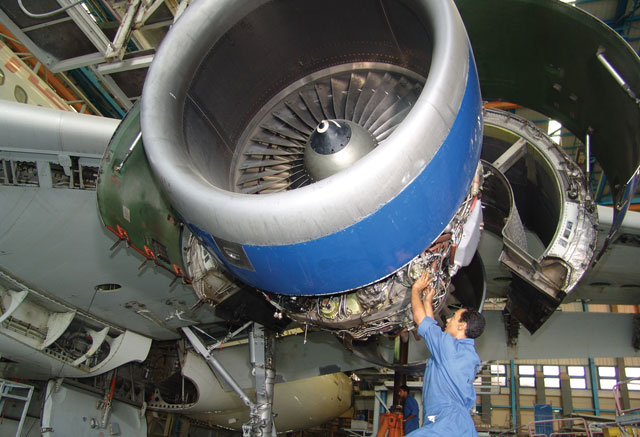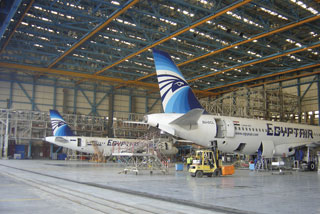EgyptAir Maintenance & Engineering (M&E) has been particularly affected by the civil unrest throughout the Arab world that began two years ago. But despite the continuing political instability in the country, the company says that its business is improving.
When Egypt's president Hosni Mubarak was ousted in February 2011, EgyptAir's operations were temporarily halved, with load factors dropping to 30% and revenues falling by 80%.
Air traffic declined for EgyptAir and other carriers, especially to holiday destinations, which affected the company's line maintenance business. But demand for custom third-party maintenance, repair and overhaul (MRO) also fell as client airlines put their work on hold.
 |
|---|
EgyptAir Maintenance & Engineering EgyptAir M&E has opened an overhaul shop in co-operation with Rolls-Royce and Lufthansa |
Even though the state carrier's operations recovered later that year, the MRO division replaced its chairman and chief executive, Abdel Aziz Fadel, with his deputy, Saied El-Mekkawy, in December 2011. El-Mekkawy had only moved to the vice-chairman position two months earlier. But he too was replaced in October 2012, when Abou Taleb Tawfik took over the helm.
But in overall terms, EgyptAir M&E says that it has only been "slightly affected" by the continuing instability in Egypt. The maintenance company declines to provide specific financial results. It says that profits fell in the fiscal year 2010/11, but it did not make a loss.
Revenues grew by 11% in FY2011/12, which led to an accumulated 25% increase in turnover over FY2008/09. The MRO provider says its operations have returned "almost back" to the same levels just before January 2011, after gaining new customers and even expanding its capacity. For the current FY2012/13 period, the company expects more growth than last year.
Third-party maintenance revenues declined because a number of main customers - including its parent carrier - put work on hold. This was particularly the case for other Arab airlines, which were affected by instabilities in their home markets. But EgyptAir M&E says that the third-party MRO situation has improved "quite well" over the past six months.
Only a few employees have been made redundant. As a government-owned company, EgyptAir M&E cannot lay off any staff. But the aftermarket player concedes that it reduced a "minor" number of older employees who had already reached their retirement age.
CHANGING MIX
Half of EgyptAir M&E's business revolves around airframe maintenance, while component support accounts for 30% of its custom work. Engine MRO stands at 13%, with the remainder generated through continued airworthiness management services.
 |
|---|
EgyptAir Maintenance & Engineering EgyptAir plans to renew its mature fleet |
Full overhaul capabilities exist for CFM International CFM56-5C as well as International Aero Engines V2500-A1 and -A5 powerplants. CFM56-3C, Pratt & Whitney PW4090, PW4158 and Rolls-Royce Trent 700 engines can be dissembled to module level and tested. Some 50 engines can be serviced a year at the moment.
Two years ago, EgyptAir M&E planned to expand its overhaul capabilities to CFM56-7B engines by 2014, but it is not clear whether that timetable is still being pursued. Today, the MRO firm says that it is studying to support another CFM56 variant. The company has disclosed plans to start repairing individual engine parts in future, for which it currently depends on external service providers.
At the moment, EgyptAir M&E utilises around two-thirds of its total MRO capacity. There were plans in late 2010 to build four new hangars by 2025, with construction work for the first three-bay facility due to begin in 2014. In the meantime, however, the maintenance provider has decided to "postpone the starting point for its master facility plan", depending on its business development over the next few years. This will also allow the company to respond to the requirements of future aircraft, it adds, as the parent airline's current fleet consists of mature types.
EgyptAir plans to order new aircraft by the end of 2013. The carrier is analysing its fleet requirements for the next 10 years and expects to complete the study in March. Ehab Ghazi, the airline's deputy vice-president of planning, expressed confidence in early December that Egypt's political situation would stabilise within the next 12 months.
Source: Flight International



















